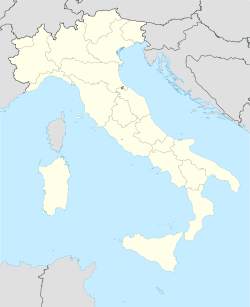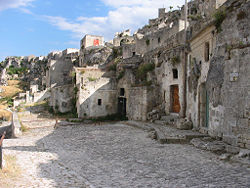Matera
| Comune di Matera | |
|---|---|
 |
|
| Country | |
| Region | Basilicata |
| Province | Matera (MT) |
| Mayor | Emilio Nicola Buccico |
| Elevation | 401 m (1,316 ft) |
| Area | 387.4 km² (149.6 sq mi) |
| Population (as of December 31, 2004) | |
| - Total | 59,144 |
| - Density | 153/km² (396/sq mi) |
| Time zone | CET, UTC+1 |
| Coordinates | |
| Gentilic | Materani |
| Dialing code | 0835 |
| Postal code | 75100 |
| Frazioni | La Martella, Venusio, Picciano A, Picciano B |
| Patron | Madonna della Bruna |
| - Day | July 2 |
| Website: www.comune.matera.it | |
Matera is a town and a province in the region of Basilicata, sometimes referred to as Lucania, in the south of Italy.
Apart from an economy which has traditionally been based on agriculture, in the late 1990s the major economic base of Matera, and of surrounding cities, is the production of upholstered furniture.
The town lies athwart a small canyon, which has been eroded in the course of years by a small stream, the Gravina.
Contents |
History

The area of what is now Matera has been settled since the Palaeolithic. The city was allegedly founded by the Romans in the 3rd century BC, with the name of Metheola after the consul Lucius Caecilius Metellus.
In AD 664 Matera was conquered by the Lombards and became part of the Duchy of Benevento. In the 7th and 8th centuries the nearby grottos were colonized by both Benedictine and Greek-Orthodox monastic institutions.
The 9th and 10th centuries were characterized by the struggle between Saracens, Byzantines and the German emperors, including Louis II, who destroyed the city. After the settlement of the Normans in Apulia, Matera was ruled by William Iron-Arm from 1043.
After a short communal phase and a series of pestilences and earthquakes, the city in the fifteenth century became an Aragonese possession, and was given in fief to the barons of the Tramontano family. In 1514, however, the population rebelled against the oppression and killed Count Giovanni Carlo Tramontano. In the seventeenth century Matera was handed over to the Orsini and then became part of the Terre d'Otranto di Puglia. Later it was capital of Basilicata, a position it retained until 1806, when Joseph Bonaparte reassigned it to Potenza.
In 1927 it became capital of the Matera province. On September 21, 1943, the Materani rose against the German occupation, the first Italian city to fight against the Wehrmacht.
Main sights
The Sassi
| I Sassi di Matera* | |
|---|---|
| UNESCO World Heritage Site | |
 |
|
| State Party | |
| Type | Cultural |
| Criteria | iii, iv, v |
| Reference | 670 |
| Region** | Europe and North America |
| Inscription history | |
| Inscription | 1993 (17th Session) |
| * Name as inscribed on World Heritage List. ** Region as classified by UNESCO. |
|

Matera has gained international fame for its ancient town, the "Sassi di Matera" (meaning "stones of Matera"). The Sassi originate from a prehistoric (troglodyte) settlement, and are suspected to be some of the first human settlements in Italy.
The Sassi are houses dug into the tuff rock itself, which is characteristic of Basilicata and Puglia. Many of these "houses" are really only caverns, and the streets in some parts of the Sassi often are located on the rooftops of other houses. The ancient town grew in height on one slope of the ravine created by a river that is now a small stream. The ravine is known locally as "la Gravina".
In the 1950s, the government of Italy forcefully relocated most of the population of the Sassi to areas of the developing modern city. However, people continued to live in the Sassi, and according to the English Fodor's guide:
| “ | Matera is the only place in the world where people can boast to be still living in the same houses of their ancestors of 9,000 years ago. | ” |
Until the late 1980s this was considered an area of poverty, since these houses were, and in most areas still are, mostly unlivable. Current local administration, however, has become more tourism-oriented, and has promoted the re-generation of the Sassi with the aid of the European Union, the government, UNESCO, and Hollywood. Today there are many thriving businesses, pubs, and hotels.
One of the benefits of the ancient city, is that there is a great similarity in the look of the Sassi with that of ancient sites in and around Jerusalem. This has caught the eye of film directors and movie studios.
Monasteries and churches
Like every city or town in Italy, Matera has a number of churches. However, nowhere else in Italy, and possibly even the world, will one see such a diverse collection of buildings related to the Christian faith. Some even believe that the very first "churches" ever used for worship were formed in the slopes of the surrounding ravine.
The Cathedral (1268–1270) is an important monument, and has been dedicated to Santa Maria della Bruna since 1389. Built in an Apulian-Romanesque architectural style, the church has a 52m tall bell tower, and next to the main gate is a statue of the Maria della Bruna, backed by those of Sts. Peter and Paul. The main feature of the façade is the rose window, divided by sixteen small columns. The interior is on the Latin cross plan, with a nave and two aisles. The decoration is mainly from the 18th century Baroque restoration, but recently a Byzantine-style fourteenth-century fresco portraying the Last Judgment has been discovered.
There are many other churches and monasteries dating back throughout the history of the Christian church. Some are simple caves with a single altar and maybe a fresco, often located on the opposite side of the ravine. Some are complex cave networks with large underground chambers, thought to have been used for meditation by the rupestric and cenobitic monks.
Cisterns and water collection
Matera was built above a deep ravine called Gravina of Matera that divides the territory into two areas. Matera was built such that it is hidden, but made it difficult to provide a water supply to its inhabitants. Early dwellers invested tremendous energy in building cisterns and systems of water channels.
Other ancient remains

The Tramontano Castle that was begun in the early sixteenth century by Gian Carlo Tramontano, Count of Matera, is probably the only other structure that is above ground of any great significance outside of the sassi. However, the construction remained unfinished after his assassination in the popular riot of 29 December 1514. It has three large towers, while twelve were probably included in the original design. During some restoration work in the main square of the town, workers came across what was believed to be the main footings of another castle tower. However, on further excavation large Roman cisterns were unearthed. Whole house structures were discovered where one can see how the people of that era lived. Found under the main square of the modern city was a large underground reservoir, complete with columns and a vaulted ceiling.
Culture
Because of the ancient and primitive scenery in and around the Sassi, it has been used by filmmakers as the setting for ancient Jerusalem. The following famous biblical period motion pictures were filmed in Matera:
- Pier Paolo Pasolini’s The Gospel According to St. Matthew (1964).
- Bruce Beresford’s King David (1985).
- Mel Gibson’s The Passion of the Christ (2004).
- Catherine Hardwicke’s The Nativity Story (2006).
Other famous movies filmed in the city include:
- Alberto Lattuada's La Lupa (1953)
- Giuseppe Tornatore's The Star Maker (1995)
- The Omen (2006)
A chapter on Matera describing the life of people in the south of Italy at the beginning of the twentieth century is in the book Cristo si è fermato a Eboli (Christ stopped at Eboli) by Carlo Levi. This was also turned into a film.
See also
- Giovanni Carlo Tramontano, Count of Matera
Notes and references
External links
- UNESCO site
- Matera - The Festivity of the Madonna della Bruna
- Museo Laboratorio della Civiltà Contadina
- BBC News: Italian cave city goes hi-tech
- Matera Photos
- Sassi di Matera PHOTO Tour
- The rock-hewn churches map of Matera
- Video Festa della Bruna (English)
- Video Sassi di Matera and Rupestral Churches (English)
|
|||||||||||||||
|
|||||||
